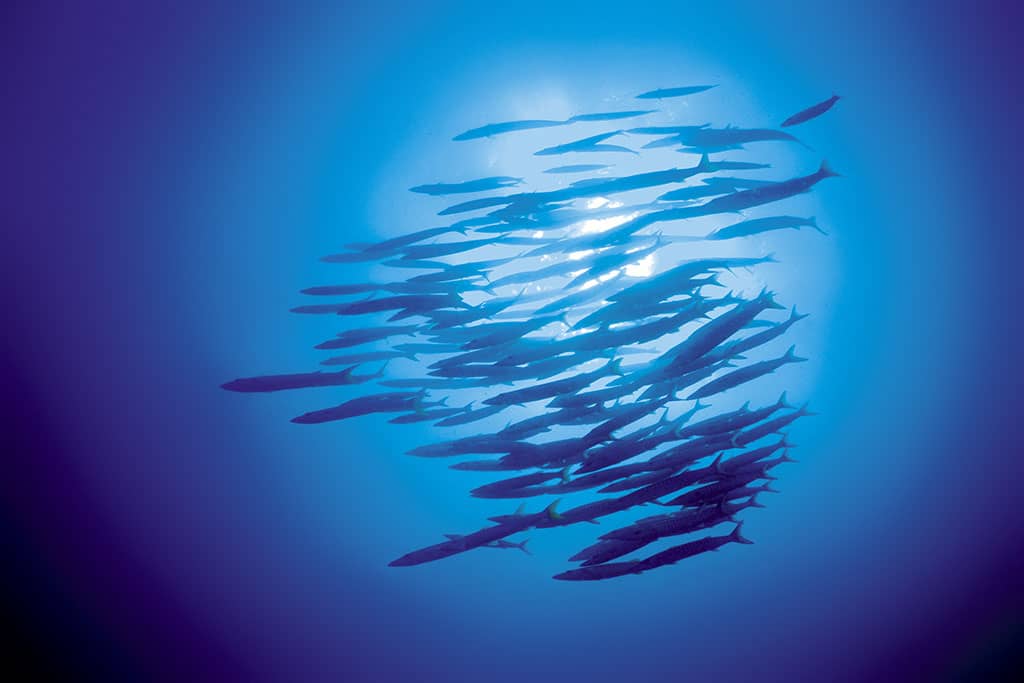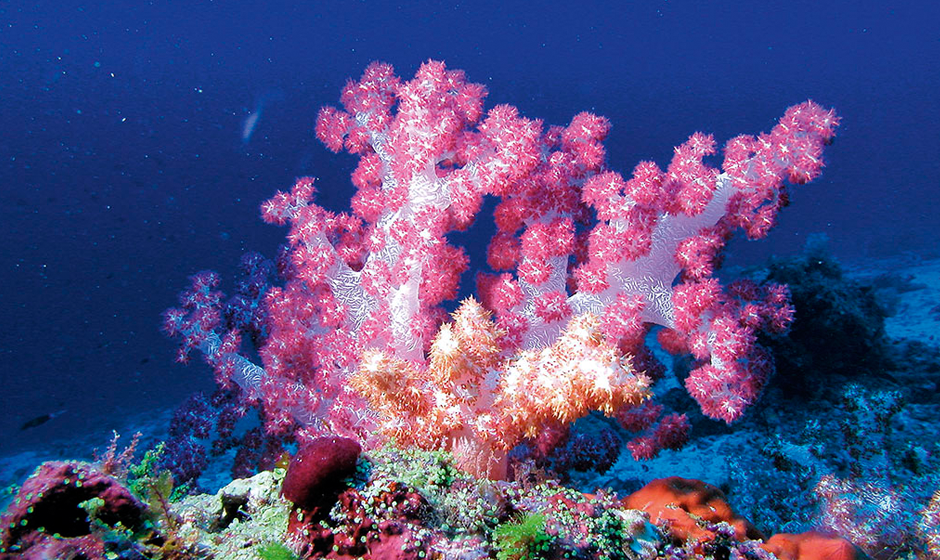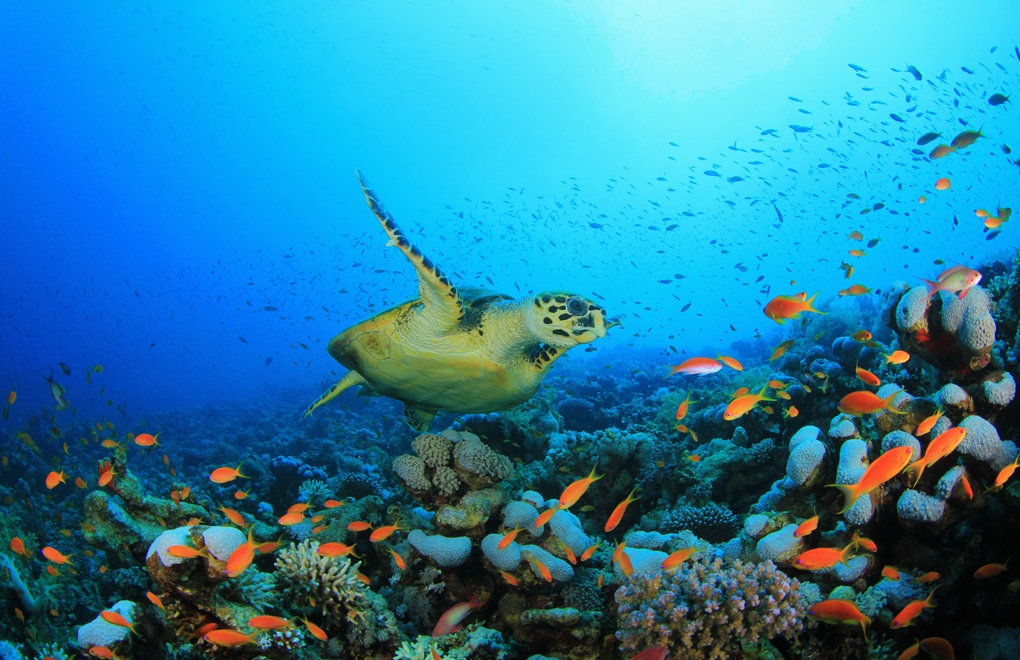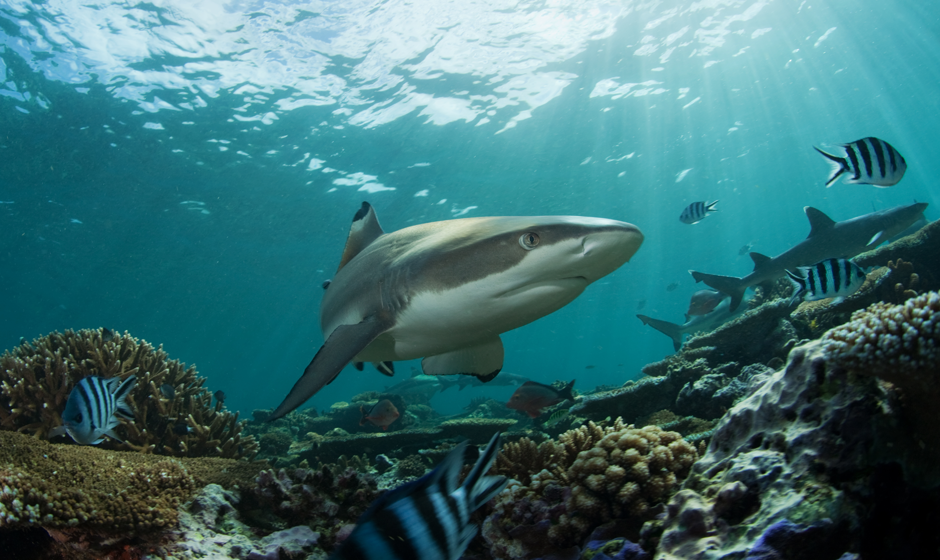Marine biologist Robin Aiello shares 7 expert scuba diving and snorkelling tips for you to maximise your experience in the clear waters of the Indian Ocean.
During her visit to Constance Halaveli in the Maldives, Robin leads immersive dive and snorkel excursions, offering guests the opportunity to explore the vibrant marine life up close.
Whether you’re a seasoned diver or a first-time snorkeler, have a careful look at thid guidance before embarking in a fabulous under-water adventure.
1. Scan the area – Look down, look out, look up
Let your eyes relax and scan the whole area – don’t look at anything in particular, just take in the whole reef. Do this at regular intervals. Take a wide panoramic view. You might spot a large manta ray is cruising past in the deep water, or a tuna is speeding by just above your head.
Large schools of snapper or fusiliers attract larger predators, such as barracudas and tuna. Take the time to hang back and observe for a while – sometimes, out of the blue one of these large hunters will dash through the fish trying to grab one.

Baracudas
2. Use your peripheral vision
When diving in the Indian Ocean, pay attention to your peripheral vision – any sudden movement or flash of colour is worth investigating.
You might be fortunate enough to witness an octopus deftly feeding among the coral, a turtle leisurely grazing, or even a titan triggerfish energetically tearing apart the reef in search of a tasty morsel.
Each of these encounters offers a fascinating glimpse into the vibrant and dynamic underwater world.
3. Fauna’s weird behaviours
The ocean in the Maldives is full of mystery and one of the best spots for diving. There, you may encounter some peculiar events or scenes; so pay attention to ‘weird behaviours’:
- You may see a fish floating vertically on its head with its tail up, or the other way around with the head up and tail down. Fish don’t usually act this way so it’s worth stopping and enjoying the performance.
- What if the fish is flexing its gills, opening its mouth wide, like a yawn (fish don’t yawn, by the way!), or does it look like it is dazed and tilting sideways? Try to get closer to have a look – there are most likely some very small, blue and white fish darting around the fish. These are cleaner wrasses that play a very important role for fish by cleaning off harmful parasites. As they’re completing their duty, they also ‘massage’ the fish to help it relax. As they relax, the fish change colour, which in turn allows the cleaner fish to see the parasites easier.
- What about a fish wiggling its body sideways, flat against the reef or the sand? Look closer – you could be watching a female laying its eggs, or a male fertilising freshly laid eggs.
- Are two fish, head to tail, spinning in tight circles around one another – like two dogs in a dog fight? You are probably witnessing fish spawning.
- When a small tightly packed school of fish suddenly dash to the surface, then burst apart and swim back to the reef, what does it mean? This is another style of fish spawning.
4. Watch you back and look behind you
Animals, even marine wildlife, avoid approaching other animals from the front. Instead, they would rather creep up from behind where they are less easily seen. This is even true of fish.
I can’t tell you how many times I have seen turtles, rays, reef sharks and trevallies (jacks) following divers, staying only a few feet from their fins, and the divers were completely oblivious.
In fact, just last week while diving at Halaveli in some very strong current, we were hanging on the reef flat doing our safety stop when one of my guests started gesturing to me to look behind – and sure enough there, nearly touching my fins, was a beautiful white tip reef shark!
5. Focus in close
Every so often shift your focus and concentrate on a small area of the reef – whether on the reef flat, or on a steep wall face, or under an overhang. Regulate your buoyancy and stay in one place, hovering close to the reef, and select an area of about one square metre. You will be amazed by how much marine life you can see in this small patch.
Slowly scan side-to-side, taking in all the small animals and plants. Be sure to look in the nooks and crannies – that is where many of the small shrimps and crabs hide out.
Do you see something moving, like thin white strings sticking out of the hole and waving around? Look closer – it is probably the antennae of the red-banded cleaner shrimp. They use their antennae like a neon billboard to advertise that they are open for business. This practice is meant for fish or other animals to come bay and get cleaned. During this act, the shrimp use their long claws to pick off parasites and dead skin.
6. Pick one thing to look at
Scan the panorama and seek for one thing. It could be a soft coral, a sea fan, a sea anemone, you name it. Focus exclusively on it and don’t be distracted. Let your eyes adjust so you are looking at all the small details. Look for tiny animals that live there.
Small shrimp, sometimes transparent or the colour of the object it is sitting on, or small parasitic snails, or teeny fish looking for even smaller prey. Look all around – some crabs like to hide on the undersides for better protection.
In bushy soft corals you can sometimes find delicate ghost pipefish or long-nosed hawkfish that stay so still, and are so well camouflaged, that you can barely see them, even when they are right in front of your nose. But they are there to be found.

Coral reefs at Constance Moofushi
7. Stop and listen
Sound travels much faster underwater than in the air, and marine animals use sound for all sorts of communication. Stop and listen carefully. You will be amazed when you can hear it too.
The reef is alive with sound. The crunching of the parrotfish as they graze algae off the reef, the clicking of shrimps as they snap their claws together, the woosh of tuna as they attack a school of fish, and the drumming noise of fish defending their territory.
They do this by using their air bladder (swim bladder) – an internal sac structure that is filled with air, that they inflate and deflate to maintain buoyancy. Surrounding the sac they have muscles, which if quickly flexed will strike against the air bladder and make a noise – like a drum. Many fish use this during spawning to attract females, or as a warning alarm.
Get your wetsuit on and be ready for the fun
So before scuba diving or snorkelling, remember – Stop, take your time, do not rush through the dive. Stop, look closer and see the incredible underwater world unfold in front of your eyes.
See you soon at Constance Hotels and Resorts!
Robin








No Comments